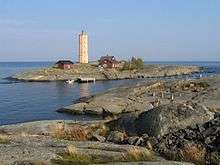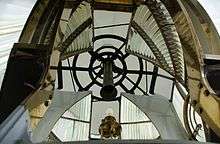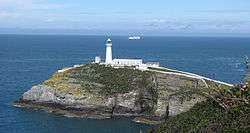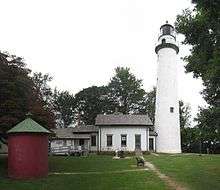Lighthouses
Lighthouses are structures that are prominent by day and lit at night to help sailors navigate, with complementary roles: to warn them to stay away, or to indicate safe passage and the way into harbour. There must be many thousands of them worldwide, if every harbour light at the end of a breakwater is counted, but this page only describes those with some kind of interior structure that you can visit.
Understand
The very first lighthouse probably began as a daymark, ie a prominent structure without a light. This was on the little island of Pharos just off Alexandria in Egypt, where the coast is low and featureless, and you could easily come to grief by sailing into the wrong channel. But that was no help at night or in poor visibility, so circa 300 BC a tower with a light was built, burning sheep hides soaked in olive oil and channelling the light by bronze mirrors. Pharos came to mean the lighthouse itself, and lighthouses in general, and was adapted into other languages (e.g. modern French phares headlights). The original tower fell into disuse by the 12th C and its stone was recycled or eaten by coastal erosion.
The ancient and medieval world largely got by with makeshift lighthouses, but sea commerce expanded greatly in the modern period, the loss of ships, lives and cargo escalated, and something better was needed. The golden age of lighthouse building was in the 18th & 19th C, with great towers (often heroically constructed in dangerous locations) housing not only equipment but people to tend the light, and whatever they needed to live isolated for weeks or months on end. So it's often these structures that make for the most interesting visits. They have light sources, lenses and shutter mechanisms, emitting a unique identifying pattern of flashes. They have stoves and bunks, precarious steps up from the boat landing, and great views from the top over windswept, white-capped waters.
During the 20th C lights became more reliable and compact, and other aids to navigation developed, such as radar, sonar depth-finders, radio telecoms, and later satnav. Existing lighthouses were made automatic, decommissioned or altogether demolished; new "lighthouse" equivalents were just metal towers festooned with aerials and dishes. Note them from a distance, there's no need to go close, the very point they're there to make. The listings below are sites that you can visit and in some sense "get inside". They may or may not be operational - if they are, visits may be suspended at short notice for maintenance. Openings may be at routine hours or on special occasions or highly dependent on the weather. If there's a tricky access by boat or cliff path, getting there is half the fun, or all the misery as you upchuck your breakfast. Many lighthouses are museums, but this listing doesn't include museums that simply contain lighthouse artefacts, because just about every coastal museum does so.
Where there was no suitable rock to build a lighthouse upon, lightships where sometimes used. With the invention of screw-pile and later caisson lighthouses, most of these became obsolete. Lightships are included below, where these can be boarded. A few act as museums in some harbour.
See
The entries below just give basic details of location, facilities and access. See the linked destination articles for more about how to get there, opening hours, prices, and what's there.
Estonia
- 🌍 Kõpu lighthouse, ☎ +372 5299 162, e-mail: info@tuletornikohvik.ee. 1 May–15 September 10:00–20:00. Built in the 16th century, the Kõpu lighthouse is one of the oldest lighthouses still in use, globally. It is situated on land in Hiiumaa, quite far from the shore, with restaurant and other tourist amenities close by. The newer Ristna lighthouse, built in 1874, is at the outer end of the Kõpu peninsula in the west towards the Baltic Sea proper. Also Tahkuna lighthouse is nearby, to the north, towards the Gulf of Finland. €2/1, the three €5/2.
Finland

Listings from east to north:
- 🌍 Söderskär (Royal Line from Helsinki Kauppatori market), ☎ +358 400-502-771, e-mail: majakka@soderskar.fi. Boat at 09:00 daily in summer. An old secluded lighthouse island in Gulf of Finland, in the outer archipelago in the middle of a bird reserve (in the nesting season only tours are permitted, arriving by own boat is allowed from August). Day trips from Helsinki are arranged by Royal Line, including lunch, a guided tour of the lighthouse (Finnish/English) and a couple of hours to linger on the island, but it is also possible to stay the night. Day cruise €52/25, hostel starting at €40/person.
- 🌍 Bengtskär, ☎ +358 2 466-7227. Skerry in the outer archipelago by the mouth of Gulf of Finland, with the tallest lighthouse in the Nordic countries. Tours from Kasnäs in Kimitoön and from Hangö, with optional dinner, sauna, accommodation etc.
- 🌍 Utö. Utö lighhouse marks the entrance to the fairways through the Archipelago Sea to the main ports of south-western Finland 80 km away. It stands on the southernmost year-round inhabited island in Finland, of less than 1 km² and a few dozen inhabitants. When the original lighthouse was built here in 1753 it was the first in Finland. Guided tours in the lighthouse daily in summer
- 🌍 Märket. June–August Tu–Th 09:00 or by request. Lighthouse in the Sea of Åland, on a tiny skerry, a DXCC entity of its own (Market reef) and the smallest sea island shared by two countries. Trips of 4–5 hours (one hour each way) arranged by the Käringsund guest harbour in Eckerö. Guided tour, coffee and seal watching. Proper clothes and footwear needed. Cancelled in bad weather or with few customers (unless specially arranged).
- 🌍 Isokari (Enskär). The lighthouse, built 1833, tallest in the Gulf of Bothnia at 49.4 m, is on an island in Bothnian Sea National Park (also Kylmäpihlaja and Säppi are in the park). It was built at the entrance of a fairway through the Archipelago Sea from the Bothnian Sea to the Baltic Sea proper, avoiding the Swedish coast. Tours from Uusikaupunki €49/25 (dinner in Uusikaupunki included).
Germany

- 🌍 Museum im Leuchtturm (Museum in lighthouse), Kap Arkona, Baltic Sea. 3 different styles of lighthouse
- 🌍 Lindau Lighthouse, Lindau, Lake Constance. Climb the lighthouse (33m) built in 1856. Views are great from that height.
- 🌍 Westerheversand lighthouse. A lighthouse on the Eiderstedt peninsula (near St. Peter Ording) in the well-known red-white striped color scheme that has been used in TV advertisements.
Spain
- 🌍 Tower of Hercules (Torre de Hércules), A Coruña. Built in the 2nd century this is probably the oldest lighthouse still in use.
United Kingdom
It's no surprise that so many lighthouses are dotted around the coast of Britain. An island nation that was one of the first countries to industrialise, and to develop overseas colonies, its need for safe sea trade was pressing. Britain sought to "rule the waves" but this claim was challenged: there were continual wars with France, the English Channel was often unsafe for merchant shipping, and if you did chance it by hugging the shore, the Eddystone Rocks lay in wait. Vessels for the Atlantic might prefer to sail the long way round via the tip of Scotland, but this, as the Spanish Armada had discovered, was also dangerous. So lighthouses were essential, which forced the technology to enable their construction: cement that would set underwater made possible the second Eddystone lighthouse of 1755. The great name was Robert Stevenson (1772-1850), who built his first lighthouse at 19, and oversaw fifty years of their construction. So when we think of lighthouses, we think of his classic design, those tapering white or hooped towers flashing from a headland. As iconic as they were practical, they became as symbolic of island Britain as the fluted marble column is symbolic of Ancient Greece.
England

Trinity House operate all lighthouses and lightships in England, Wales and the Channel Isles. See their website for details of access, operational closures, and self-catering accommodation within lighthouses.
- The Roman Lighthouse, located within Dover Castle, is the last standing Roman Lighthouse in Britain.
- 🌍 Smeatons Tower (on The Hoe in Plymouth). Originally the third Eddystone Light, but in the 19th C it was relocated to the mainland (replacing an obelisk daymark), as the rocks on which it stood on had been undermined by erosion, causing it to shake from side to side whenever large waves hit, a less than ideal proposition for a reliable "light". The "fourth" Eddystone light built on firmer foundations, is still operational (and in 1982 was one of the first automated by Trinity House).
- 🌍 Lizard Lighthouse Heritage Centre Lizard Lighthouse Heritage Centre, Cornwall.
- 🌍 Portland Bill, Isle of Portland.
- 🌍 South Foreland Lighthouse, The Front, St Margaret's Bay, Dover, CT15 6HP, ☎ +44 1304 852463, e-mail: southforeland@nationaltrust.org.uk.
- 🌍 Flamborough Head Lighthouse, Flamborough Scarborough.
- 🌍 Souter Lighthouse and The Leas, South Tyneside. Lighthouse which was in use until 1988, now run by the National Trust. The lighthouse opened in 1871, and was the first in the world to use a.c. electric current. The lighthouse used arc lamps and had its own generator.
- 🌍 Longstone Lighthouse (aka Outer Farne). This light house is on the The Farne Islands, a set of islands in the North Sea. It's best known for its association with Grace Darling, who under atrocious conditions, rescued 9 passengers from the angry sea. The Longstone Lighthouse visitor centre is part of a more general tour of the Farne Islands. Owing to its location, access understandably depends on conditions and the discretion of tour boat operators.
- Ellesmere Port lighthouse is on shore, joined with the harbourmaster's office. Often called Whitby lighthouse but not to be confused with that town in Yorkshire.
Scotland

The Northern Lighthouse board operates all lighthouses around Scotland and the Isle of Man. See their website for access details, operational closures, and self-catering accommodation within lighthouses.
- 🌍 Arbroath Signal Tower Museum, Arbroath. Museum in a building built in 1813 as the shore base for the Bell Rock Lighthouse
- 🌍 Museum of Scottish Lighthouses, Fraserburgh. Lighthouse museum in Kinnaird Head Lighthouse which was the first lighthouse in mainland Scotland (built in 1787) inside the castle which dates from 1570.
- 🌍 Start Point Lighthouse, Sanday. Operational, limited access.
- 🌍 North Ronaldsay Lighthouse, Orkney. Operational, limited access.
- 🌍 Sumburgh head Lighthouse, Shetland. Operational, limited access.
- 🌍 Ardnamurchan Lighthouse, Ardnamurchan. Operational, limited access.
- 🌍 Skerryvore Lighthouse Museum, Tiree. Shore station for a lighthouse built between 1838 and 1844. The lighthouse is on some rocks 12 miles away. There is an exhibition on the building of the lighthouse. Free, but donation appreciated.
- 🌍 Mull of Galloway, lighthouse, Drummore. Operational, limited access.
Wales

And see Trinity House link above.
- 🌍 South Stack Lighthouse, South Stack, Anglesey. Built in 1809 and still operational, it stands impressively on a rocky island just off the coast. Reached by steep steps and bridge.
- 🌍 Nash Point Lighthouse, Glamorgan. Operational and open weekends in summer, this was the last manned lighthouse in Wales.
Channel Islands
Alderney, Open by arrangement with the States of Alderny, and Trinity House, this light guarding the Alderny race is open for viewing , limited Sundays in the Summer.
India
- 🌍 Alappuzha lighthouse. This lighthouse was built in 1862. Alappuzha was one of the major trading centers and active ports in Kerala.
- 🌍 Kannur lighthouse (Cannanore lighthouse). Located in Kannur, Kerala (state); this active lighthouse is near the Arabian Sea.
- 🌍 Lighthouse, Chennai (Madras Lighthouse). This lighthouse was built in 1977 replacing the older one. It is located on the east coast near Chennai in the Bay of Bengal. It was recently opened to visitors.
United States
California
- Point Reyes Lighthouse at Point Reyes National Seashore, Marin County
Florida

Visiting and photographing Florida lighthouses are celebrated hobbies, and the lighthouses are popular travel destinations, as they are maintained as tourist attractions. National Lighthouse and Lightship Weekend is celebrated in the US on the first weekend of August, and International Lighthouse and Lightship Weekend is celebrated on the third weekend. Many lighthouses are open to the public and amateur radio operators often communicate between them on these days.
- Egmont Key Light – The Egmont Key Lighthouse lies in Central Florida, in the mouth of Tampa Bay at the opening to the Gulf of Mexico. It is only accessible by boat. There are daily ferries that leave from Ft. Desoto State park. They range in price depending on time and age of the person going.
- Ponce de Leon Inlet Light – At 175 feet high, this is the tallest lighthouse in Florida, located in the town of Ponce Inlet. The site includes a lighthouse museum.
Michigan

- 🌍 Pointe aux Barques Light (north of Port Hope (Michigan)). Built in 1848
Uruguay
- 🌍 The lighthouse of Colonia. 14:00-18:00. For a nominal fee you can go up to the top of the lighthouse (faro) and see most of the city and look out over the city and Rio de la Plata. On a clear day probably even Buenos Aires is visible. The lighthouse was built in 1857. UYU20 (as of May 2014).
- 🌍 Punta Carretas lighthouse (Faro de Punta Carretas) (Montevideo). On the southernmost peninsula of the city. You get to walk a bit to get there. For a small fee you can get up in the tower, but the view over the city across the small bay is good from the ground too. The peninsula seems to be a quite popular spot for hobby fishers. UYU20 (as of May 2014).
Stay safe
Lighthouses are often on cliff edges which may be unfenced. Keep well back from the edge, bearing in mind that the edge may give way due to erosion.
Some lighthouse islands are accessible only in fine weather; landing can be difficult and dangerous, and unless there is a safe harbour one should get away in time if weather turns rough.
The tower of a lighthouse often has many steep steps. The railings at the top may be designed for adult lighthouse keepers, so be particularly careful if visiting a lighthouse with children.
Don't monkey with the equipment! It's either a valuable museum piece, or operational and the next life it saves might be your own.